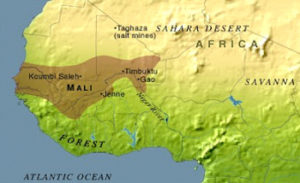
*The Mali Empire is celebrated on this date in 1235. Historically referred to as the Manden Kurufaba, it was an empire in West Africa from c. 1235 to 1670.
Sundiata Keita founded the empire and became renowned for the wealth of its rulers, especially Mansa Musa (Musa Keita). The Manding languages were spoken in the empire. At its peak, Mali was the largest empire in West Africa, profoundly and widely influencing the region's culture by spreading its language, laws, and customs. Much of the recorded information about the Mali Empire comes from 14th-century North African Arab historian Ibn Khaldun, 14th-century Moroccan traveler Ibn Battuta, and 16th-century Moroccan traveler Leo Africanus. The other major source of information is the Mandinka oral tradition, recorded by storytellers known as griots.
The empire began a small Mandinka kingdom at the upper reaches of the Niger River, centered around the town of Niani (the empire's namesake in Manding). During the 11th and 12th centuries, it began to develop as an empire following the decline of the Ghana Empire, or Wagadu, to the north. During this period, trade routes shifted southward to the savanna, stimulating the growth of states such as Boman. The early history of the Mali Empire (before the 13th century) is unclear, as there are conflicting and imprecise accounts by both Arab chroniclers and oral traditionalists. Keita was the first ruler for which there is accurate written information (through Ibn Khaldun). He was a warrior prince of the Keita dynasty who was called upon to free the Mali people from the rule of the king of the Sosso Empire, Soumaoro Kanté. The conquest of Sosso in c. 1235 gave the Mali Empire access to the trans-Saharan trade routes.
Following the death of Sundiata Keita in c. 1255, the kings of Mali were referred to by the title Mansa. In c. 1285, Sakoura, a former royal court slave, became emperor and was one of Mali's most powerful rulers, greatly expanding the empire's territory. He made a pilgrimage to Mecca but died on his voyage home. After the reigns of three more emperors, Musa Keita became Mansa in c. 1312. He made a famous pilgrimage to Mecca from 1324 to 1326. His generous gifts to Mamluk Egypt and his expenditure of gold caused significant inflation in Egypt. Maghan I succeeded his father as Mansa in 1337 but was deposed by his uncle Suleyman in 1341. It was during Suleyman's 19-year reign that Ibn Battuta visited Mali. Suleyman's death marked the end of Mali's Golden Age and the beginning of a slow decline.

The Mali Empire reached its largest area under the Laye Keita Mansas. Al-Umari describes the empire as south of Marrakesh and almost entirely inhabited except for a few places. Mali's domain also extended into the desert. He describes it as north of Mali but under its domination, implying some vassalage for the Berber tribes. The empire's total area included nearly all the land between the Sahara Desert and coastal forests. By 1350, the empire covered approximately 478,819 square miles (1,240,140 km2). The empire also reached its highest population during the Laye period, ruling over 400 cities, towns, and villages of various religions and movements. During this period, only the Mongol Empire was larger. The dramatic increase in the empire's growth demanded a shift from the Manden Kurufaba's organization of three states with twelve dependencies. This model was scrapped by the time of Mansa Musa's hajj to Egypt; there were fourteen provinces (or, more accurately, tributary kingdoms).
Mali was still a sizeable state in the 15th century. The Venetian explorer Alvise Cadamosto and Portuguese traders confirmed that the peoples of the Gambia were still subject to the Mansa of Mali. Upon Leo Africanus's visit at the beginning of the 16th century, his descriptions of the territorial domains of Mali showed that it was still a kingdom of considerable area. However, from 1507 onwards, neighboring states such as Diara, Great Fulo, and the Songhay Empire chipped away at the outer borders of Mali.
In 1542, the Songhay invaded the capital city of Niani but were unsuccessful in conquering the empire. During the 17th century, the Mali Empire faced incursions from the Bamana Empire. After unsuccessful attempts by Mansa Mama Maghan to conquer Bamana, in 1670, the Bamana sacked and burned Niani. The Mali Empire rapidly disintegrated and ceased to exist, replaced by independent chiefdoms. The Keitas retreated to the town of Kangaba, where they became provincial chiefs.